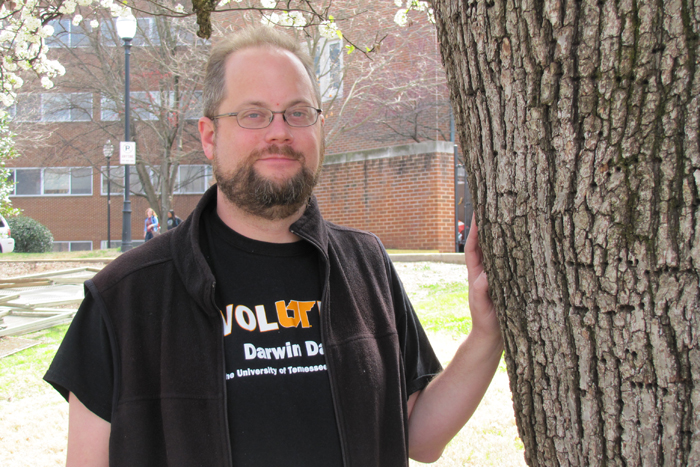Nick Matzke: Reconstructing Species Migrations Across Time

This ScienceLives article was provided to Live Science in partnership with the National Science Foundation.
Nick Matzke is a computational biogeographer at the National Institute for Mathematical and Biological Synthesis. He studies the distribution of plant and animal species, particularly from a historical perspective, taking into account the evolutionary relationships of species over millions of years. Thus, Matzke develops methods that combine historical and ecological biogeography. Viewing species distributions in this manner, he suggests, will help scientists build better models and make stronger predictions about what will happen to species as the climate warms.
Name: Nick Matzke Institution: National Institute for Mathematical and Biological Synthesis Field of Study: Computational biogeography
What is your field and why does it inspire you? / Why did you choose this field?
I am a computational biogeographer, which means I study where plant and animal species live, how they got there, and where they might be going in the future. I am particularly interested in “historical biogeography,” which attempts to reconstruct the history of species migrations around the planet over millions of years of evolution.
This field inspires me for three reasons.
First, biogeography gave Charles Darwin and Alfred Russel Wallace one of the first big hints that different species must be related by common ancestry — descent with modification. Basically, when these scientists traveled around the world on British sailing ships, they found that similar species were typically found near to each other, whereas similar environments had entirely different species if the regions were far apart. Furthermore, volcanic islands typically lacked many major groups, like frogs and terrestrial mammals. These observations made no sense under the then-prevailing view of “special creation” of species, but it made perfect sense if descent with modification was true.
Get the world’s most fascinating discoveries delivered straight to your inbox.
Second, historical biogeography is an old field going back to the 1800s, with many longstanding debates, such as “dispersal versus vicariance.” Vicariance means that species spread out and are later broken up when environmental or oceanic barriers form, while dispersal means that rare, long-distance “jumping” events have occurred. However, the field is currently being revolutionized by statistical approaches, which attempt to answer these classic questions with formal statistical inference, rather than a priori decisions about what processes are most important.
Third, only by understanding the history of species' movements under past climate change can we maximize our ability to understand and predict the fate of species under human-caused climate change.
Please describe your current research.
My current research is focused on merging historical and ecological biogeography. Traditionally, these fields have been fairly isolated from each other in terms of methods and researchers. Ecological biogeographers focus on how environment and ecology control the distribution of presently living species. They often use a method called “species distribution modeling” to correlate species observations (from museums and field surveys) with climatic predictors (maps of temperature, precipitation, etc.). They typically build these models for a single species at a time.
However, we know that, often, closely related species will have similar environmental preferences. Thus, to do species distribution modeling “right,” we really should be taking into account the evolutionary relationships of species and estimating how fast species' environmental preferences evolve. Bringing in this evolutionary history means that we need to incorporate approaches from historical biogeography and phylogenetics. I expect this research will both improve distribution models of living species, as well as give us better reconstructions of the environmental preferences of ancestral species.
How does your work benefit society?
One big limitation of current species distribution models is that they tend to have poor “transferability.” They will work well fitting the training data (Editor's note: Training data is used to assess the strength and utility of a predictive relationship), but they can be quite poor when used to make predictions in new regions, new climates, or in paleo-environments in the past. Part of the problem is that the statistical methods used cannot “tell the difference” between the true environmental correlations with species presence and accidental correlations that are just due to the fact that every species lives somewhere, every local region on the earth has some limited environment, and species cannot disperse everywhere instantaneously.
Thus, including evolutionary relationships should help filter out the “noise” and provide models with better transferability. This is a crucial advantage when we try to predict what will happen to species as the climate warms.
What do you like best about your work?
I enjoy most teaching people to think about models and how to test their models. Often, people have never thought about biogeography this way, and it really is a “Free Your Mind” moment, à la The Matrix, when people get it. Sometimes, researchers don't realize how constrained they have been by the currently available methods.
Which professional accomplishment are you most proud of? / What stands out as your crowning achievement?
BioGeoBEARS is a software package that I created for the R statistical computing language. It really seems to have taken off, with dozens of researchers already using it, even though my article on the key model is still in review. I have given workshops on the method at Berkeley, the University of Tennessee, University of Texas at El Paso, Yale, and at meetings in French Guiana and Australia. Also, further back in my career, I had a few notable achievements in the science education arena, fighting the “intelligent design” creationists. See Google for that!
On the other hand, what has been your most discouraging professional moment and how did you recover? What did you learn?
I started off in grad school in a field I thought was practical but which I wasn't very interested in. At the time, I was very interested in evolution , but I didn't know anyone who worked in the field. I thought of it basically as the subject of popular books by the likes of Gould and Dawkins. I ended up getting a master's degree, which was very hard, since it felt like “giving up.” However, it was the best decision I ever made, as it lead me into science education and then into professional evolutionary biology for real.
What is the best professional advice you ever received?
Don't do a Ph.D. unless you are sure that's what your passion is! If you are exploring or unsure, do a master's program or an internship.
What is the most surprising aspect of your work?
I think the most surprising aspect of my work is that while statistical model testing is common in phylogenetics, and probabilistic biogeography models have been available for some time, no one has put these two tools together to try and answer some of the classic questions about biogeographic processes. The classic debate in biogeography is "dispersal versus vicariance" — when closely related species are separated by large barriers, does this represent long distance "jumps" across the barriers (dispersal), or does it mean that an ancestral species had a continuous range that was later broken up by the formation of the barrier (vicariance). Arguments have raged about this for decades, but with statistical model choice, I hope we can start to do objective hypothesis testing about these questions.
Who is your #1 hero and why?
The philosopher Mary Midgley, whose books taught me that evolutionary theory does not intrinsically lead to the bleak, reductionist worldview favored by certain evolution popularizers these days. When you read those sorts of popular science books, you get the impression that morality, consciousness and free will are illusions, and we are all really just robots controlled by our genes. These sorts of statements are just crude scientism motivated by a sort of tribal scientific triumphalism, rather than careful thinking. Bits of Midgley's work are problematic, but in the main, she has profound things to say about what evolution says about morality and meaning, if one makes the effort to read her books, which her critics never seem to do.
What do you do when you're not in the lab or out in the field?
I write for Panda's Thumb, a science blog devoted to topics on evolution and problems with creationist or “intelligent design” (ID) arguments . The blog, which was started in 2004 when blogs were a new thing, is named after the famous book and essay by Stephen Jay Gould. For many years it was the best source of information for critical review of the various pseudoscience arguments that the creationists push. Nowadays, all of us Panda's Thumb bloggers have grown up and become busier, and the ID movement has become much less prominent since the Kitzmiller v. Dover trial. But we occasionally still rouse ourselves to post when we see some cool evolution story or some creationist claim that needs debunking.
Editor's Note: The researchers depicted in ScienceLives articles have been supported by the National Science Foundation, the federal agency charged with funding basic research and education across all fields of science and engineering. Any opinions, findings, and conclusions or recommendations expressed in this material are those of the author and do not necessarily reflect the views of the National Science Foundation. See the ScienceLives archive.
 Live Science Plus
Live Science Plus






